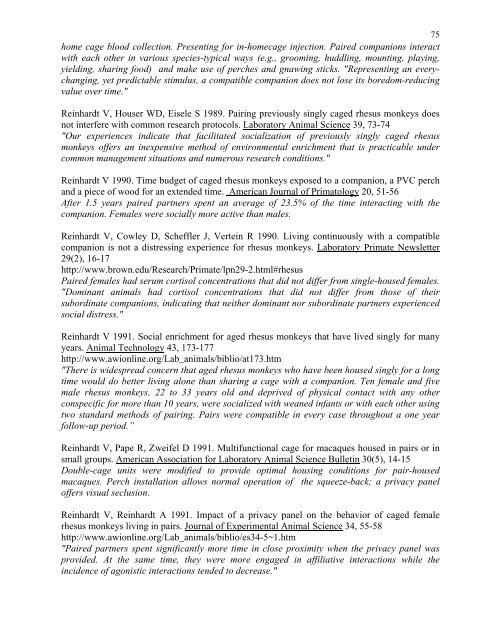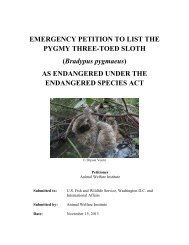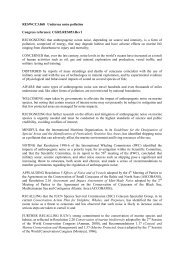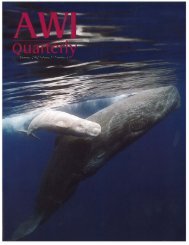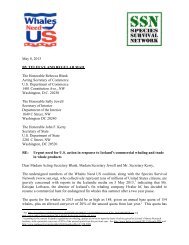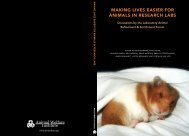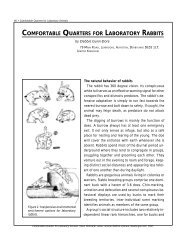Re finem for Annot ment a Prima tated nd En ates K Biblio vironm ...
Re finem for Annot ment a Prima tated nd En ates K Biblio vironm ...
Re finem for Annot ment a Prima tated nd En ates K Biblio vironm ...
Create successful ePaper yourself
Turn your PDF publications into a flip-book with our unique Google optimized e-Paper software.
75home cage blood collection. Presenting <strong>for</strong> in-homecage injection. Paired companions interactwith each other in various species-typical ways (e.g., grooming, huddling, mounting, playing,yielding, sharing food) a<strong>nd</strong> make use of perches a<strong>nd</strong> gnawing sticks. "<strong>Re</strong>presenting an everychanging,yet predictable stimulus, a compatible companion does not lose its boredom-reducingvalue over time."<strong>Re</strong>inhardt V, Houser WD, Eisele S 1989. Pairing previously singly caged rhesus monkeys doesnot interfere with common research protocols. Laboratory Animal Science 39, 73-74"Our experiences i<strong>nd</strong>icate that facili<strong>tated</strong> socialization of previously singly caged rhesusmonkeys offers an inexpensive method of environ<strong>ment</strong>al enrich<strong>ment</strong> that is practicable u<strong>nd</strong>ercommon manage<strong>ment</strong> situations a<strong>nd</strong> numerous research co<strong>nd</strong>itions."<strong>Re</strong>inhardt V 1990. Time budget of caged rhesus monkeys exposed to a companion, a PVC percha<strong>nd</strong> a piece of wood <strong>for</strong> an exte<strong>nd</strong>ed time. American Journal of <strong>Prima</strong>tology 20, 51-56After 1.5 years paired partners spent an average of 23.5% of the time interacting with thecompanion. Females were socially more active than males.<strong>Re</strong>inhardt V, Cowley D, Scheffler J, Vertein R 1990. Living continuously with a compatiblecompanion is not a distressing experience <strong>for</strong> rhesus monkeys. Laboratory <strong>Prima</strong>te Newsletter29(2), 16-17http://www.brown.edu/<strong>Re</strong>search/<strong>Prima</strong>te/lpn29-2.html#rhesusPaired females had serum cortisol concentrations that did not differ from single-housed females."Dominant animals had cortisol concentrations that did not differ from those of theirsubordinate companions, i<strong>nd</strong>icating that neither dominant nor subordinate partners experiencedsocial distress."<strong>Re</strong>inhardt V 1991. Social enrich<strong>ment</strong> <strong>for</strong> aged rhesus monkeys that have lived singly <strong>for</strong> manyyears. Animal Technology 43, 173-177http://www.awionline.org/Lab_animals/biblio/at173.htm"There is widespread concern that aged rhesus monkeys who have been housed singly <strong>for</strong> a longtime would do better living alone than sharing a cage with a companion. Ten female a<strong>nd</strong> fivemale rhesus monkeys, 22 to 33 years old a<strong>nd</strong> deprived of physical contact with any otherconspecific <strong>for</strong> more than 10 years, were socialized with weaned infants or with each other usingtwo sta<strong>nd</strong>ard methods of pairing. Pairs were compatible in every case throughout a one yearfollow-up period.”<strong>Re</strong>inhardt V, Pape R, Zweifel D 1991. Multifunctional cage <strong>for</strong> macaques housed in pairs or insmall groups. American Association <strong>for</strong> Laboratory Animal Science Bulletin 30(5), 14-15Double-cage units were modified to provide optimal housing co<strong>nd</strong>itions <strong>for</strong> pair-housedmacaques. Perch installation allows normal operation of the squeeze-back; a privacy paneloffers visual seclusion.<strong>Re</strong>inhardt V, <strong>Re</strong>inhardt A 1991. Impact of a privacy panel on the behavior of caged femalerhesus monkeys living in pairs. Journal of Experi<strong>ment</strong>al Animal Science 34, 55-58http://www.awionline.org/Lab_animals/biblio/es34-5~1.htm"Paired partners spent significantly more time in close proximity when the privacy panel wasprovided. At the same time, they were more engaged in affiliative interactions while theincidence of agonistic interactions te<strong>nd</strong>ed to decrease."


